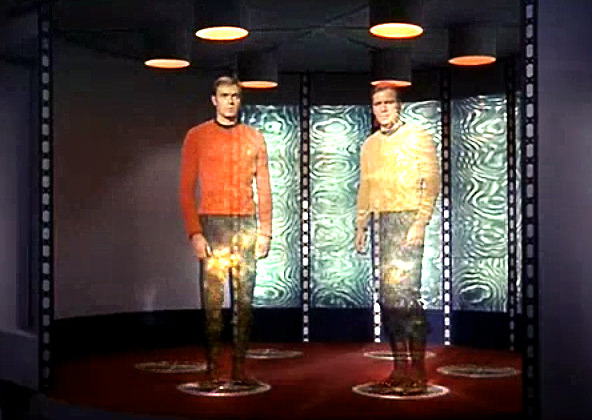It’s a crazy way to travel, spreading a man’s molecules all over the Universe…
While we’re still a very long way off from instantly transporting from ship to planet à la Star Trek, scientists are still relentlessly working on the type of quantum technologies that could one day make this sci-fi staple a possibility. Just recently, researchers at the University of Cambridge in the UK have reported ways to simplify the instantaneous transmission of quantum information using less “entanglement,” thereby making the process more efficient — as well as less error-prone.
(Because nobody wants a transporter mishap.)
In a paper titled Generalized teleportation and entanglement recycling, Cambridge researchers Sergii Strelchuk, Michal Horodecki and Jonathan Oppenheim investigate a couple of previously-developed protocols for quantum teleportation.
“Teleportation lies at the very heart of quantum information theory, being the pivotal primitive in a variety of tasks. Teleportation protocols are a way of sending an unknown quantum state from one party to another using a resource in the form of an entangled state shared between two parties, Alice and Bob, in advance. First, Alice performs a measurement on the state she wants to teleport and her part of the resource state, then she communicates the classical information to Bob. He applies the unitary operation conditioned on that information to obtain the teleported state.” (Strelchuk et al.)
In order for the teleportation to work, the process relies on entanglement — the remote connection between particles or individual bits of information regardless of the physical space separating them. This was what Einstein referred to as “spooky action at a distance.” But getting particles or information packets entangled is no simple task.
“Teleportation crucially depends on entanglement, which can be thought as a ‘fuel’ powering it,” Strelchuk said in an article on ABC Science. “This fuel… is hard to generate, store and replenish. Finding a way to use it sparingly, or, ideally, recycling it, makes teleportation potentially more usable.”
Read: Beam Me Up, Obama: Conspiracy Theory Claims President Teleported to Mars
Considering the sheer amount of information that makes up the also-difficult-to-determine state of a single object (in the case of a human, even simplistically speaking, about 10^28 kilobytes worth of data) you’re obviously going to want to keep the amount of entanglement fuel needed at a minimum.
Of course, we’re not saying we can teleport red-shirted security officers anywhere yet. But if.
Still, with a more efficient method to reduce — and even recycle — entanglement, Strelchuk and his team are bringing us a little closer to making quantum computing a reality. And it may very well take the power of a quantum computer to even make the physical teleportation of large-scale objects possible… once the technology becomes available.
“We are very excited to show that recycling works in theory, and hope that it will find future applications in areas such as quantum computation,” said Strelchuk. “Building a quantum computer is one of the great challenges of modern physics, and it is hoped that the new teleportation protocol will lead to advances in this area.”
(I’m sure Dr. McCoy would still remain skeptical.)
You can find the team’s full paper here (chock full of maths!) and read the article on ABC Science by Stephen Pincock here.
Transporter room image from TOS “Obsession” episode. © 2013 CBS Studios Inc. All Rights Reserved.




